
Putting home ownership within reach for a diverse workforce

How blockchain technology is changing treasury

Administrator accountability: 5 questions to evaluate outsourcing risks

Blockchain: Separating hype from substance

Commercial real estate in 2020: Keeping up with the pace of change

Hybridization driving demand

The AI journey in finance: How to make it part of your strategy

Supply chain analysis: Merging technology and commerce

The ongoing evolution of custody

3 emerging technology trends for bankers

The startup scene in Reno: The story of Breadware

The startup scene in Reno: Emerging tech leads the way

Finance or operating lease? Deciphering the legalese of equipment finance

Common pitfalls to avoid in the equipment financing process

Buying or leasing? Questions to ask before signing a contract

High-yield bond issuance: 5 traits lawyers should look for in a service provider

Easier onboarding: What to look for in an administrator

Luxembourg's thriving private debt market

3 questions to ask your equity, quant and CTA fund administrator

3 tips to maintain flexibility in supply chain management

Private equity and the full-service administrator

The secret to successful service provider integration

Insource or outsource? 10 considerations

10 ways a global custodian can support your growth

Refining your search for an insurance custodian

The benefits of a full-service warehouse custodian

4 questions you should ask about your custodian

Preparing for your custodian conversion

Service provider due diligence and selection best practices

Emerging A/R solutions use artificial intelligence to target efficiency

Colleges respond to student needs by offering digital payments

6 timely reasons to integrate your receivables

Benefits of billing foreign customers in their own currency

Drivers for changing accounts receivable in 2021

Integrated receivables management solution supports customer focus at MSC Industrial Supply

Improve government payments with electronic billing platforms

Webinar: Digitizing receivables to transform B2B rent payments

Hospitals face cybersecurity risks in surprising new ways

Webinar: Robotic process automation

Tactical Treasury: Fraud prevention is a never-ending task

Webinar: Empower your AP automation with strategic intelligence
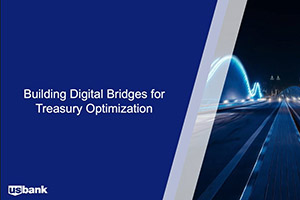
Webinar: Building digital bridges for treasury optimization

Evaluating interest rate risk creating risk management strategy

Authenticating cardholder data reduce e-commerce fraud

Webinar: Digitize your AP processes to optimize results

Webinar: AP automation—solve payment challenges with an invoice-to-pay solution

Webinar: CRE technology trends
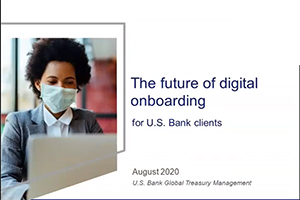
Webinar: The future of digital onboarding for U.S. Bank clients
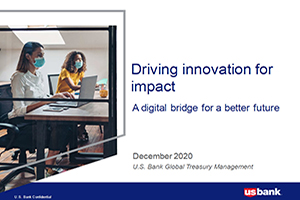
Webinar: Driving innovation to impact treasury management

Webinar: CRE treasury leader roundtable
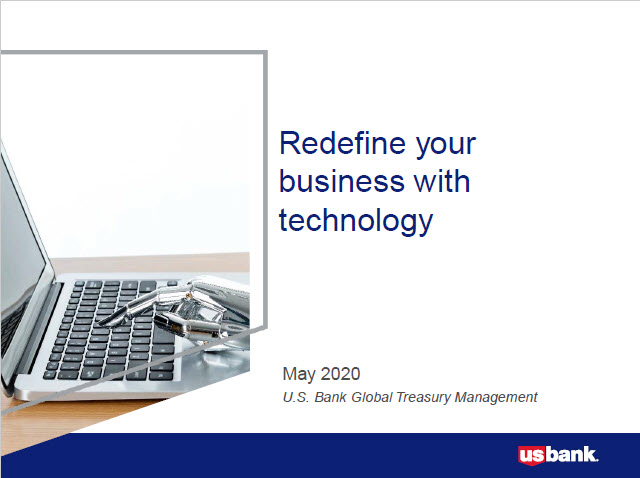
Webinar: Redefine your business with technology
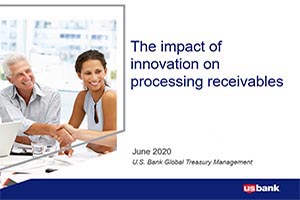
Webinar: The impact of innovation on processing receivables

5 Ways to protect your government agency from payment fraud
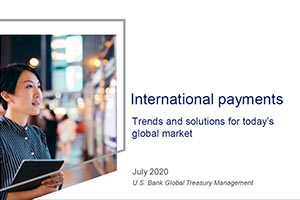
Webinar: International payments

Complying with changes in fund regulations

The cyber insurance question: Additional protection beyond prevention

Business risk management for owners of small companies

Government agency credit card programs and PCI compliance

Drive digital transformation with payments innovation

Modernizing fare payment without leaving any riders behind

Access, flexibility and simplicity: How governments can modernize payments to help their citizens

Escheatment resources: Reporting deadlines for all 50 states

How electronic billing platforms improve government payments

How real-time inventory visibility can boost retail margins

White Castle optimizes payment transactions

Payment industry trends that are the future of POS

What government officials should know about real-time payments

Higher education strategies for e-payment migration, fighting fraud

Tap-to-pay: Modernizing fare payments pays off for transit agencies and riders

ABCs of APIs: Drive treasury efficiency with real-time connectivity

How emerging banking solutions enable better decisions

Restaurant survey shows changing customer payment preferences

Three healthcare payment trends that will continue to matter in 2022

Want AP automation to pay both businesses and consumers?

Time is money: Intelligent Payment Routing saves businesses both

Digital trends poised to reshape hotel payments

Managing the rising costs of payment acceptance with service fees

Webinar: CSM corporation re-thinks AP

Digital banking for business: How connectivity improves customer experience

Banking connectivity: Helping businesses deliver the easier, faster, more secure customer experience of the future

Adjust collections to limit impact of USPS delivery changes

How to improve digital payments security for your health system

Increase working capital with Commercial Card Optimization

Luxury jeweler enhances the digital billing and payment customer experience

Enhancing the patient experience through people-centered payments

Tech tools to keep your restaurant operations running smoothly

Unexpected cost savings may be hiding in your payment strategy

3 ways to adapt to the new payments landscape

Automate escheatment for accounts payable to save time and money

3 benefits of integrated payments in healthcare

How COVID-19 is transforming healthcare payments

Automate accounts payable to optimize revenue and payments

Top 3 ways digital payments can transform the patient experience

Addressing financial uncertainty in international business

Understanding and preparing for the new payment experience

What to know when investing in AP automation solutions

Webinar: AP automation for commercial real estate

Ways prepaid cards disburse government funds to the unbanked

How AR technology is helping advance payment processing at Avera Health

Top tips for card payments optimization

The benefits of payment digitization: Pushing for simplicity

COVID-19 safety recommendations: Are you ready to reopen?

Collect utility and telecom bill payments faster

Government billing survey: The digital transformation of the payment experience

5 winning strategies for managing liquidity in volatile times

Safeguarding the payment experience through contactless

Higher education and the cashless society: Latest trends

Zelle® helps Sunriver Resort make payments efficient and secure

3 ways to make practical use of real-time payments

Artificial intelligence in finance: Defining the terms

How AI in treasury management is transforming finance

The future of financial leadership: More strategy, fewer spreadsheets

4 benefits to paying foreign suppliers in their own currency

Choosing your M&A escrow partner

Employee benefit plan management: trustee vs. custodian

Empowering managers with data automation and integration

Delivering powerful results with SWIFT messaging and services

Digital Onboarding helps finance firm’s clients build communities

New technology streamlines M&A transactions

Why retail merchandise returns will be a differentiator in 2022

High-cost housing and down payment options in relocation

How RIAs can embrace technology to enhance personal touch

The client-focused mindset: Adapting to differing personality types

The client-focused mindset: How to network effectively

The client-focused mindset: What do clients expect?

Flexibility remains essential for public sector workforces

Automated escheatment – learn how to prevent and resolve unclaimed property

Tailor Ridge eBill case study

What corporate treasurers need to know about Virtual Account Management

Webinar: CRE Digital Transformation – Balancing Digitization with cybersecurity risk

CFO survey: A shifting focus on ESG in business

Digital receivables to meet changing demand

Webinar: Reviving mobility, what to expect

ABCs of ARP: Answers to American Rescue Plan questions for counties

CFO report: Driving growth via new business models and technology

Treasury management innovations earn Model Bank awards

Webinar: Fraud prevention and mitigation for government agencies

CFO insights: Leading the recovery for sustainable growth

Webinar: DEI tips for transforming your mobility program

Overcoming the 3 key challenges of a lump sum relocation program

For today's relocating home buyers, time and money are everything

10 tips on how to run a successful family business

Crypto + Relo: Mobility industry impacts

Empowering team members

How entrepreneurs can plan for what matters most

Streamline operations with all-in-one small business financial support

Checklist: What you’ll need for your first retail pop-up shop

Staying organized when taking payments

Tools that can streamline staffing and employee management

Key considerations for online ordering systems

Business tips and advice for Black entrepreneurs

How iPads can help increase efficiency in your salon

How mobile point of sale (mPOS) can benefit your side gig

How does an electronic point of sale help your business keep track of every dime?

Planning for restaurant startup costs and when to expect them

Opening a business on a budget during COVID-19

How to identify what technology is needed for your small business

How to test new business ideas

How to get started creating your business plan

How to redefine challenges with business collaboration

8 ways to increase employee engagement

The role of ethics in the hiring process

How to hire employees: Employee referral vs. external hiring

Tips for building a successful customer loyalty program

Give a prepaid rewards card for employee recognition

Checklist: Increase lead generation with website optimization

How to reward employees and teams who perform well

5 steps for creating an employee recognition program

How small businesses are growing sales with online ordering

Gift cards can extend ROI into 2022

Omnichannel retail: 4 best practices for navigating the new normal

Why ecommerce for small business strategy is integral

Is your restaurant Google-friendly?

3 simple brand awareness tips for your business

How a small business owner is making the workplace work for women

What you should know about licensing agreements

The growing importance of a strong corporate culture

Rethinking common time management tips

Business credit card 101

How to apply for a business credit card

Meet your business credit card support team

How Everyday Funding can improve cash flow

How a small business is moving forward during COVID-19

Prioritizing payroll during the COVID-19 pandemic

How jumbo loans can help home buyers and your builder business

Break free from cash flow management constraints

How to accept credit cards online

5 tips for managing your business cash flow

How running a business that aligns with core values is paying off

Meet the Milwaukee businessman behind Funky Fresh Spring Rolls

Improve online presence your business

How Shampoo’ed is transforming hair and inspiring entrepreneurs

The San Francisco bridal shop that’s been making memories for 30 years

How Al’s Breakfast is bringing people together

Celebrity Cake Studio’s two decades of growth and success

In a digital world, Liberty Puzzles embraces true connection

How a bar trivia company went digital during COVID-19

How a travel clothing retailer is staying true to its brand values

How community gave life to lifestyle boutique Les Sol

How a group fitness studio made the most of online workouts

How to build a content team

How Wenonah Canoe is making a boom in business last

3 ways to gain loyalty with your customers

How (and why) to get your business supplier diversity certification

Use this one simple email marketing tip to increase your reach

Year-end financial checklist

When your spouse has passed away: A three-month financial checklist

How to save money in college: easy ways to spend less

Webinar: Uncover the cost: International trip

How having savings gives you peace of mind

Allowance basics for parents and kids

Tips to overcome three common savings hurdles

3 awkward situations Zelle can help avoid

Helpful tips for safe and smart charitable giving

Dear Money Mentor: How do I set and track financial goals?

5 tips to use your credit card wisely and steer clear of debt

30-day adulting challenge: Financial wellness tasks to complete in a month

How voice-activated devices work with banks

P2P payments make it easier to split the tab

Travel for less: Smart (not cheap) ways to spend less on your next trip

Real world advice: How parents are teaching their kids about money

How to stop living paycheck to paycheck post-pay increase

Practical money tips we've learned from our dads

How to cut mindless spending: real tips from real people

6 ways to spring clean your finances and save money year-round

How to increase your savings

5 tips to use your credit card wisely and steer clear of debt

Dear Money Mentor: How do I begin paying off credit card debt?

How to spot a credit repair scam

Myth vs. truth: What affects your credit score?


